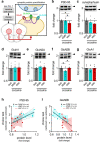GluN2B inhibition confers resilience against long-term cocaine-induced neurocognitive sequelae
- PMID: 36056105
- PMCID: PMC10209078
- DOI: 10.1038/s41386-022-01437-8
GluN2B inhibition confers resilience against long-term cocaine-induced neurocognitive sequelae
Abstract
Cocaine self-administration can disrupt the capacity of humans and rodents to flexibly modify familiar behavioral routines, even when they become maladaptive or unbeneficial. However, mechanistic factors, particularly those driving long-term behavioral changes, are still being determined. Here, we capitalized on individual differences in oral cocaine self-administration patterns in adolescent mice and revealed that the post-synaptic protein PSD-95 was reduced in the orbitofrontal cortex (OFC) of escalating, but not stable, responders, which corresponded with later deficits in flexible decision-making behavior. Meanwhile, NMDA receptor GluN2B subunit content was lower in the OFC of mice that were resilient to escalatory oral cocaine seeking. This discovery led us to next co-administer the GluN2B-selective antagonist ifenprodil with cocaine, blocking the later emergence of cocaine-induced decision-making abnormalities. GluN2B inhibition also prevented cocaine-induced dysregulation of neuronal structure and function in the OFC, preserving mature, mushroom-shaped dendritic spine densities on deep-layer pyramidal neurons, which were otherwise lower with cocaine, and safeguarding functional BLA→OFC connections necessary for action flexibility. We posit that cocaine potentiates GluN2B-dependent signaling, which triggers a series of durable adaptations that result in the dysregulation of post-synaptic neuronal structure in the OFC and disruption of BLA→OFC connections, ultimately weakening the capacity for flexible choice. And thus, inhibiting GluN2B-NMDARs promotes resilience to long-term cocaine-related sequelae.
© 2022. The Author(s), under exclusive licence to American College of Neuropsychopharmacology.
Conflict of interest statement
The authors declare no competing interests.
Figures





Similar articles
-
Sex-specific effect of prenatal alcohol exposure on N-methyl-D-aspartate receptor function in orbitofrontal cortex pyramidal neurons of mice.Alcohol Clin Exp Res. 2021 Oct;45(10):1994-2005. doi: 10.1111/acer.14697. Epub 2021 Sep 29. Alcohol Clin Exp Res. 2021. PMID: 34523139 Free PMC article.
-
Induction and Blockade of Adolescent Cocaine-Induced Habits.Biol Psychiatry. 2017 Apr 1;81(7):595-605. doi: 10.1016/j.biopsych.2016.09.023. Epub 2016 Oct 6. Biol Psychiatry. 2017. PMID: 27871669 Free PMC article.
-
Activity-dependent control of NMDA receptor subunit composition at hippocampal mossy fibre synapses.J Physiol. 2018 Feb 15;596(4):703-716. doi: 10.1113/JP275226. Epub 2018 Jan 30. J Physiol. 2018. PMID: 29218821 Free PMC article.
-
Enhancement of the GluN2B subunit of glutamatergic NMDA receptors in rat brain areas after cocaine abstinence.J Psychopharmacol. 2021 Oct;35(10):1226-1239. doi: 10.1177/02698811211048283. Epub 2021 Sep 29. J Psychopharmacol. 2021. PMID: 34587833
-
Cocaine-induced changes in NMDA receptor signaling.Mol Neurobiol. 2014 Oct;50(2):494-506. doi: 10.1007/s12035-014-8636-6. Epub 2014 Jan 21. Mol Neurobiol. 2014. PMID: 24445951 Free PMC article. Review.
Cited by
-
Dysfunction of the NMDA Receptor in the Pathophysiology of Schizophrenia and/or the Pathomechanisms of Treatment-Resistant Schizophrenia.Biomolecules. 2024 Sep 6;14(9):1128. doi: 10.3390/biom14091128. Biomolecules. 2024. PMID: 39334894 Free PMC article. Review.
-
Discovery of GluN2A subtype-selective N-methyl-d-aspartate (NMDA) receptor ligands.Acta Pharm Sin B. 2024 May;14(5):1987-2005. doi: 10.1016/j.apsb.2024.01.004. Epub 2024 Jan 10. Acta Pharm Sin B. 2024. PMID: 38799621 Free PMC article. Review.
-
Dissociating the incubation of appetitive and consummatory behavior in a model of oral cocaine self-administration.bioRxiv [Preprint]. 2025 Feb 13:2025.02.12.637922. doi: 10.1101/2025.02.12.637922. bioRxiv. 2025. Update in: Pharmacol Biochem Behav. 2025 Sep;254:174055. doi: 10.1016/j.pbb.2025.174055. PMID: 39990380 Free PMC article. Updated. Preprint.
References
Publication types
MeSH terms
Substances
Grants and funding
LinkOut - more resources
Full Text Sources

